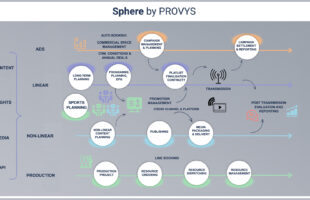It might be dated to term television, a traditional medium. Today, there is nothing traditional about it at all. Content providers and even telecom operators are bringing television content to more households and viewers, via various innovative platforms such as mobile applications and the internet.
Some industry observers foresee that this trend of allegiance will be increasingly pronounced in the near future.
Central to this idea of synergy, is the nascent but fast growing relationship between television content and gaming, two things not normally used in the same sentence previously. Of course, gaming, per sé, has been around a long time but now content makers are seeing gaming – be it web-based or as mobile apps – as a new way to access and connect with their target audience.
Statistics from a Chetan Sharma study show that mobile app usage is indeed ballooning. According to the analysis, in 2009, the total number of app downloads globally was approximately 7 billion, with Asia leading at 37 per cent. The study predicts that by 2012, the number is expected to grow 92 per cent to almost 50 billion downloads globally per year.
The Nielsen App Playbook survey added to these fi gures. It found that games make up the most popular genre of mobile apps, in terms of number of downloads and ratio of people who downloaded them. 60 per cent of the subjects surveyed who said they had downloaded an app in the last 30 days also played a gaming app during the same period. Looking at such numbers, gaming is a lucrative avenue for television, making the strengthening of their relationship inevitable. Where the two used to be competitors, they now see a reason to complement one another.
Graham Perkins, Co- CEO, Business, Rune Entertainment, is one such observer who believes the trend is just gathering steam. “I think we’ll see more integration between live broadcast and mobile, not just based on the delivery of content but through the participation of audiences – pervasive interaction with tablet devices”, he said.
At present however, there is little data available to support the direct effect of gaming in steering consumers to television. But other evidence shows that some take this initial industry excitement very seriously.
National History New Zealand’s (NHNZ) Flutter and Celestial Pictures’ My Kingdom games are two examples of this burgeoning relationship.
Back in 2009, NHNZ set up an entire gaming unit, Runaway, to reap the potential rewards that gaming could bring in by exposing television content to a bigger, yet-to-be-tapped audience.
Setting up the division represented a strategy to stay ahead of the industry. John Crawford, General Manager of NHNZ, said, “The industry is always evolving and it’s up to us to ensure we stay ahead of the game. Quite literally, in this case, we set up Runaway to extend our production expertise into interactive experiences, which build both viewership and revenue for our channel partners.”
Tim Nixon, Director of Runaway, said the potential of building viewership is defi nitely great. “Games can drive a new audience to a TV series and vice versa,” said Nixon. “A broadcaster might be looking to penetrate that market and with a game it gives that kind of engagement and direct access.”
The move seems to have worked out so far. NHNZ’s Flutter made it to number seven on Games.com’s list of the Top 10 new Facebook games of 2010. The game’s interface and gameplay refl ects NHNZ’s television content – natural world factual programming.
The success of Flutter has already prompted the New Zealand-based subsidiary of Fox International Channels to create a second game called Puzzle Planets, based on its documentary special, Clash of the Continents, which premiered on National Geographic Channel last year.
Closer to home, Celestial Pictures, the Hong Kong-based TV and fi lm company, recently launched the fi rst ever gaming application developed to accompany a Chinese movie.
For the Asian broadcaster, known for its classic kungfu movies, entering the gaming frontier was also a strategic decision. Ross Pollack, its CEO, told TV ASIA Plus, “From back in 2009, we went to the board and very clearly agreed to take a transmedia, 360-type of approach to the business.”
But unlike NHNZ who made a meticulous and detail-oriented game title, Celestial’s My Kingdom mobile game app (based on the movie of the same name) was created primarily as a means to promote the fi lm, the entertainment company’s fi rst movie release in six years. The end product was a basic music-based game, which Pollack himself said was “made on a shoestring budget”.
“In this particular case, we wanted to do something different on the marketing side and use mobile and web-based technology to help to market the fi lm. As a result, we came up with the idea of creating a game application to achieve that,” he said.
Pollack added that it is too early to tell if the game will prove to be a success but shared with TV ASIA Plus plans to develop more such content if My Kingdom hits the mark. In fact, although only in its initial stage, Pollack said Celestial is “already working on another game, which is based on one of our Shaw Brothers Library movies.”
Interestingly, providers catering to niche audiences have launched mobile apps as well. For example, Cinemacraft, a Japanese provider of interactive mobile content solutions, launched Cinemacraft Jazzdoraku, a Japanese jazz video-on-demand (VOD) application, last month. The app aims to bring such music to local fans and eventually the larger international community on a different, mobile platform.
But it’s not just content makers getting in on the act; PayTV operators are also launching such initiatives. In July, Singapore’s StarHub launched FooD.I.Y, currently available on the iPhone and iPad, which allows users to access a library of recipes and specially edited videos from world-renowned chefs featured on the operator’s food channels, such as TLC and Food Network Asia. There’s also StarHub TV on Mobile, a mobile app which allows tablet and smartphone users an on-the-go, personal viewing experience with news and entertainment content from some of its channels.
“Content providers are increasingly looking at offering their content on avenues over and above the traditional TV platform because these will help them reach out to more people,” especially since more people are turning to computers and smartphones for more personal viewing experiences than ever before,” said Iris Wee, Vice President of Home Solutions and Content.
The need for developing mobile apps becomes especially crucial in today’s landscape, where the audience is always seeking a more interactive and customizable experience. Wee told TV ASIA Plus it was largely with this in mind that the FooD.I.Y and StarHub TV on Mobile apps were developed.
“We (StarHub) see ourselves not just as an aggregator of content but also playing the role of a curator where we customize the content we distribute and make it relevant to different target audiences, since we have the knowledge and insights to what our customers want,” said Wee.








